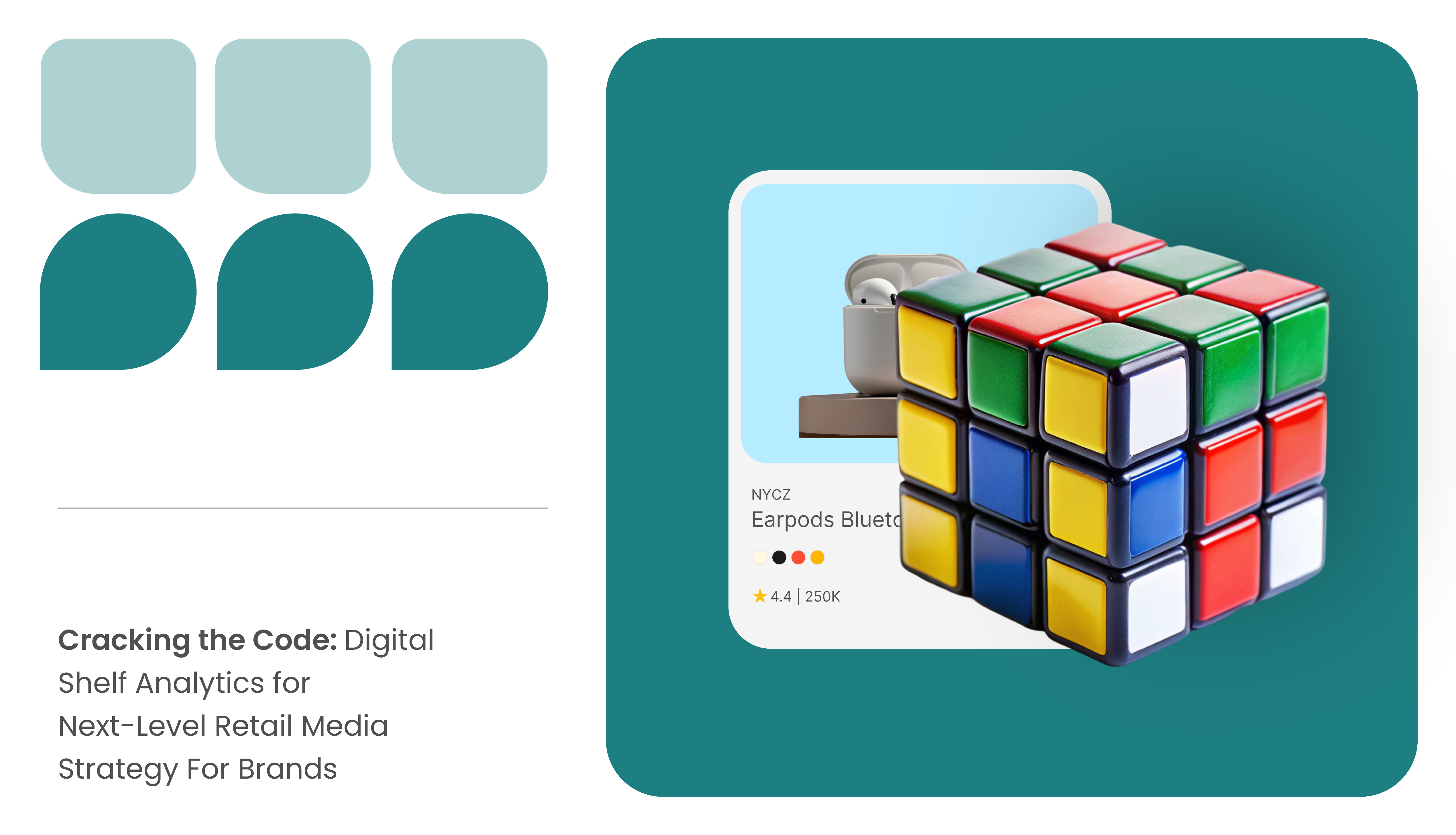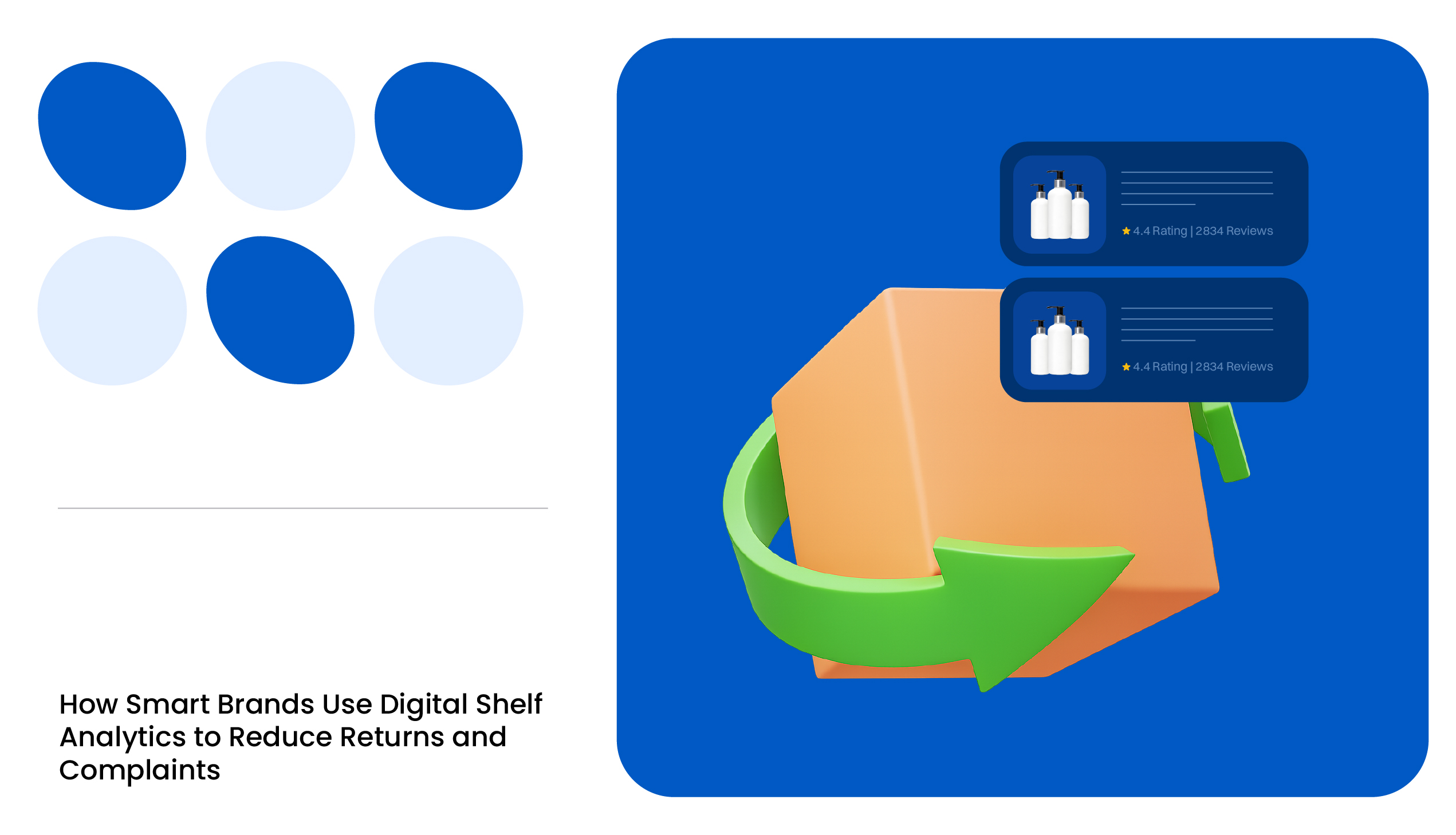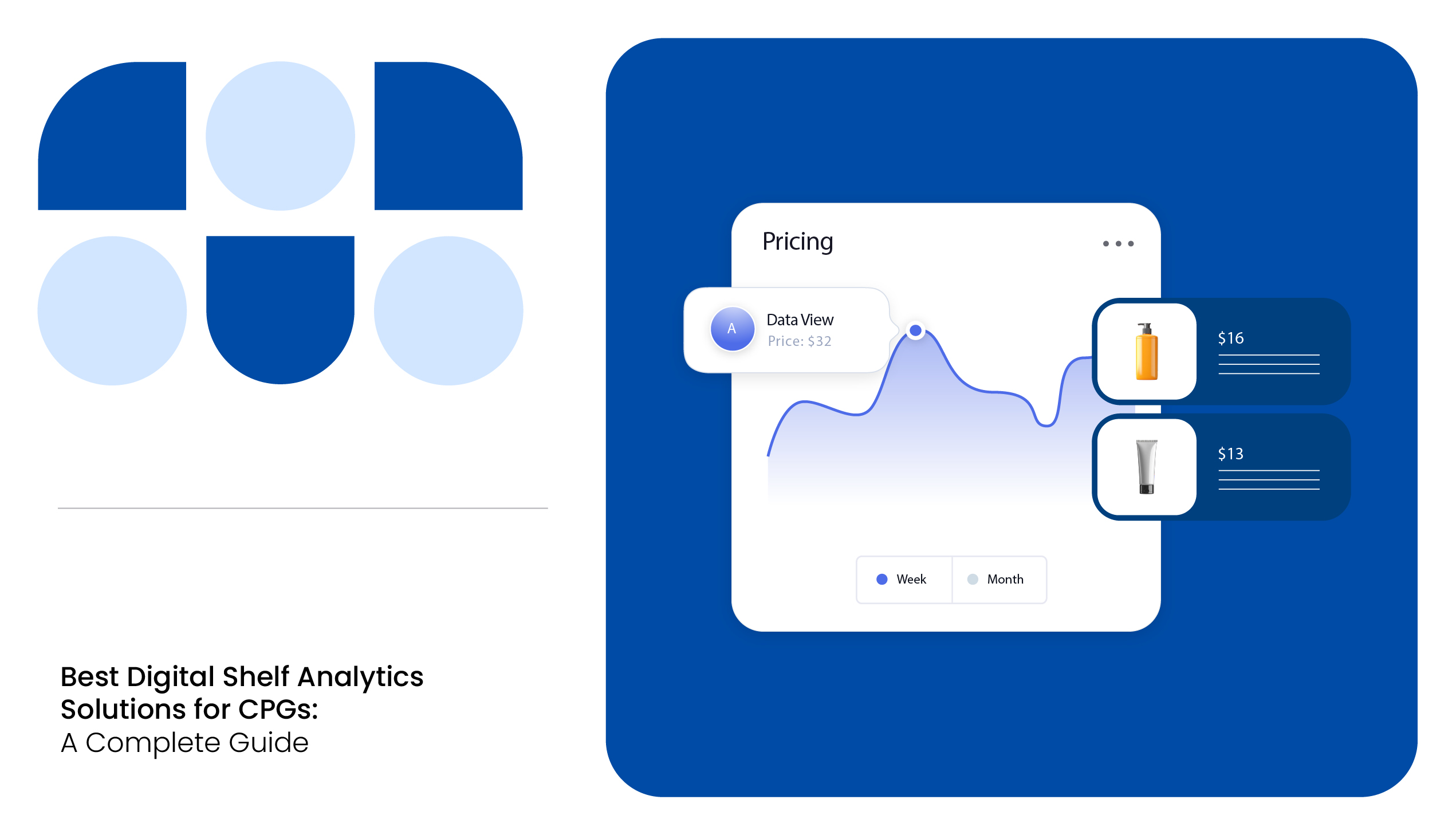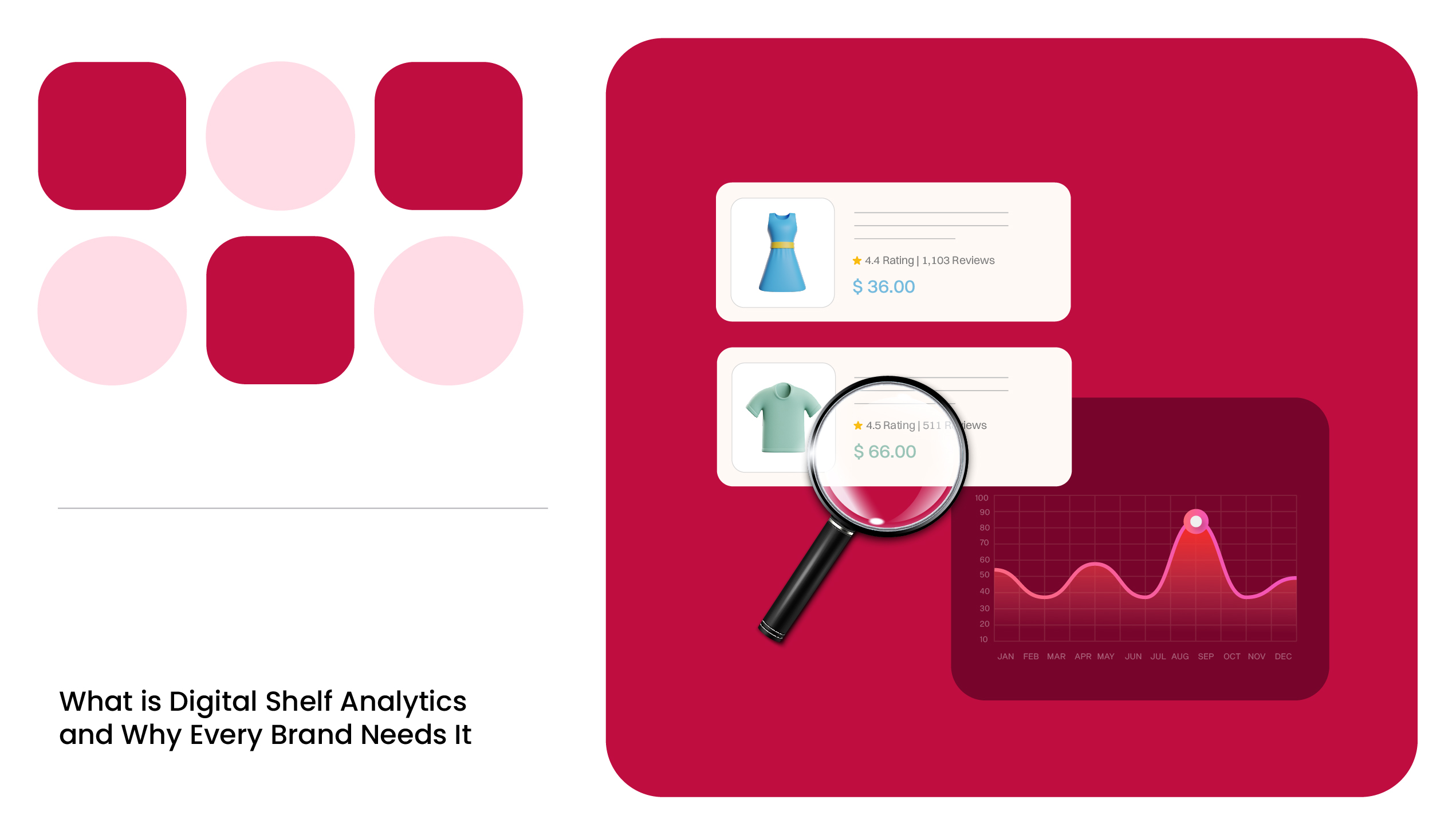Imagine spending thousands on retail media ads only to discover your products are buried on the second page of search results or, worse, marked as out of stock. It’s the digital equivalent of throwing money into a leaky bucket.
But what if you could plug those leaks and ensure that every dollar you spend on ads drives actual results? Enter digital shelf analytics, a much-needed tech stack that helps e-commerce brands make the right retail media strategy.
If you’re ready to unlock the full potential of your ad budget, read on to see why digital shelf analytics software is the secret weapon every e-commerce professional needs.
READ MORE | Confused about which digital shelf analytics tool to choose? Check out our blog on How To Pick the Best Digital Shelf Analytics Vendor in 2024
Challenges Faced by Retail Media Marketers
Retail media marketers are tasked with navigating an increasingly complex e-commerce landscape. With enormous ad spending on major online retail platforms, the stakes have never been higher.
To achieve retail media efficiency, the integration of digital shelf data can prove to be a game changer at different levels. These include:
- Overall category analysis, including pricing and competitor monitoring
- Daily store-level digital shelf data that includes stock monitoring
- Software-level intuitive dashboards and multi-channel integrations
Despite the rapid growth, retail media campaigns often face significant challenges that can undermine their effectiveness and ROI. Let’s delve into some of the most pressing issues confronting retail media marketers today.
Poor Search Visibility
The success of a retail media campaign is closely tied to search visibility. If your products aren’t ranking high in search results for relevant keywords, even the most creative and expensive ads can fall flat.
Poor visibility not only wastes your ad budget but also makes it difficult to compete with rivals who dominate the top positions.
Out-of-Stock Products
Running ads for products that are out of stock is a common yet costly mistake. Shoppers clicking on unavailable items are left frustrated, and the wasted ad spend eats into campaign ROI.
Moreover, consistently running ads for out-of-stock items can tarnish your brand’s reputation, making it harder to win back customer trust.
Suboptimal Product Content
Retail media ads may drive traffic to product pages, but if those pages lack engaging content, conversion rates will plummet. Inconsistent titles, missing images, or vague descriptions can all deter potential buyers.
Poor product content doesn’t just harm sales; it also impacts your click-through rates and overall campaign efficiency.
Missing Customer Reviews and Sentiment
Customer reviews are a critical component of a product’s online presence, influencing both shopper behavior and ad performance. Positive reviews can enhance credibility, while negative feedback can derail sales.
Retail marketers often struggle to incorporate review insights into their retail media strategies, leaving valuable data untapped.
Competition Monitoring
The retail media space is highly competitive, with brands vying for attention in the same categories. Marketers need to keep a constant eye on competitors’ pricing, promotions, and advertising strategies to avoid being outmaneuvered.
Without access to accurate, real-time data, staying ahead of the competition becomes a daunting task.
Lack of Integration Between Retail Media and Digital Shelf Performance
Retail media campaigns don’t exist in isolation; they are deeply connected to the health of your digital shelf data. However, many marketers fail to integrate these two critical aspects, resulting in fragmented strategies and suboptimal performance.
When digital shelf issues like poor search rankings or incomplete product content are ignored, retail media campaigns are unlikely to achieve their full potential.
Balancing Budgets Across Channels
With retail media platforms proliferating, deciding where to allocate your ad spend can be a headache. Each platform offers unique opportunities, but without clear insights into which channels deliver the best ROI, marketers risk spreading their budgets too thin.
Keeping Up with Evolving Marketplace Rules
E-commerce platforms frequently update their algorithms, content requirements, and advertising policies. Retail media marketers must stay on top of these changes to ensure compliance and maintain visibility. Missing a key update can result in wasted spend, delisted products, or underperforming campaigns.
Why Digital Shelf Analytics Is Crucial for Retail Media Success?
Retail media is becoming the cornerstone of e-commerce growth, with ad spending skyrocketing across platforms like Amazon, Walmart, and Instacart. According to Emarketer forecast, the US retail media ad spend is expected to reach $62.35 billion by 2025, which is a 20% increase from 2024.
But even the most creative campaigns and hefty budgets can fail if your product listings are riddled with potholes. Poor search visibility, stockouts, or unoptimized product content can render your efforts ineffective.
Digital shelf optimization bridges this gap by offering actionable insights into your product listings and ensuring your retail media campaigns operate at peak performance. Here’s how:
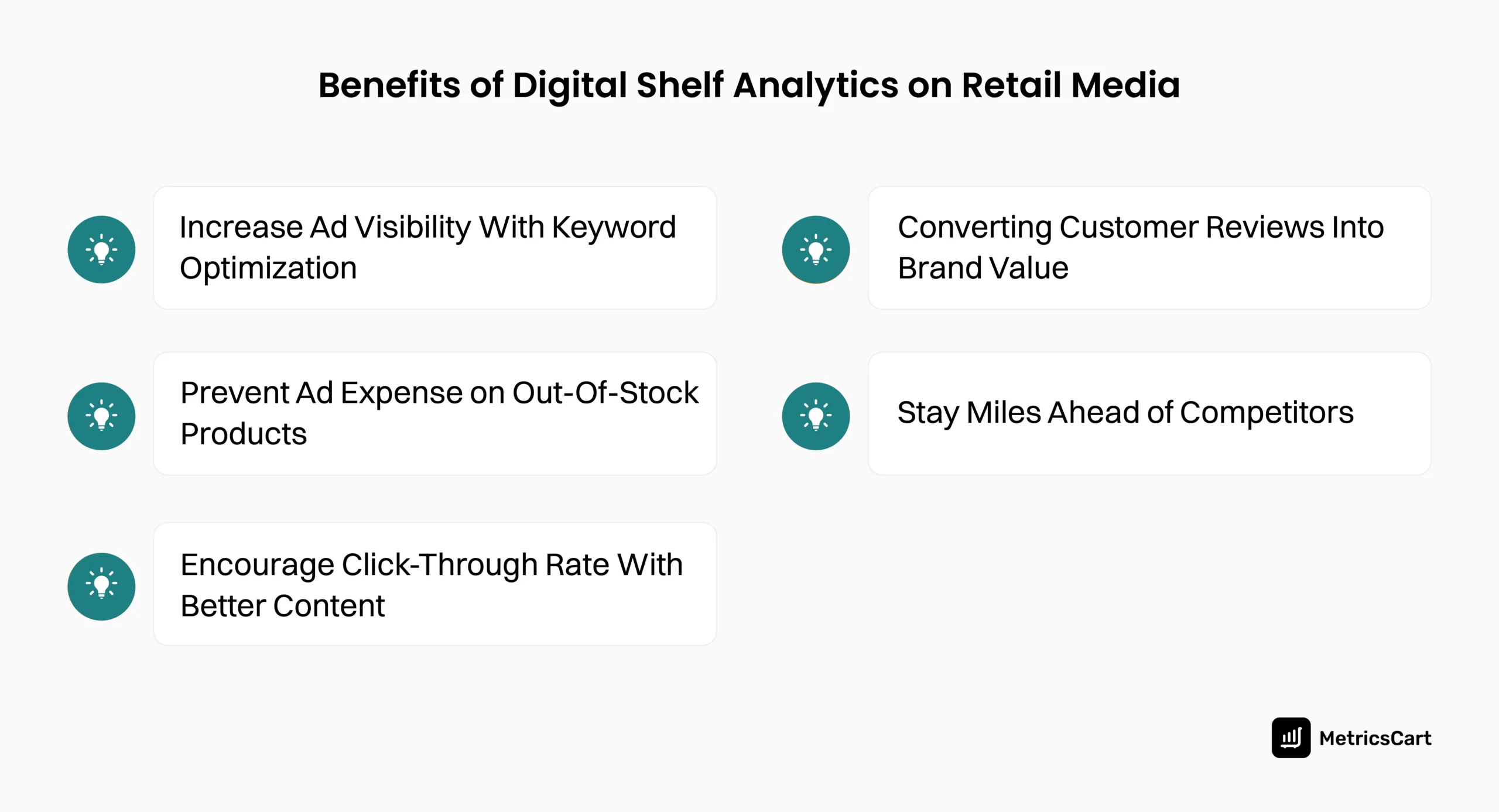
Maximizing Ad Visibility
Digital shelf analytics tools analyze your share of search for brand visibility and high-priority keywords, showing where your products rank compared to competitors. They provide actionable recommendations for keyword optimization, enabling brands to fine-tune product titles, descriptions, and bullet points.
For example, suppose a pet food brand is ranking on page two for the term “grain-free dog food,” even after running a targeted retail media campaign. In that case, digital shelf analytics tools can optimize keywords and improve organic visibility. This would enable the brand to double its ad conversions within weeks.
Preventing Out-of-Stock Ad Wastage
Running ads for out-of-stock products is one of the most common and costly mistakes in retail media. It not only wastes ad spend but also frustrates potential customers, damaging your brand reputation.
The benefits of out-of-stock monitoring include pausing ads or redirecting budgets to in-stock products. Digital shelf analytics software also helps optimize fulfillment strategies to minimize stockouts, ensuring customers always find what they’re looking for.
Focus your ad spend on products with ample inventory and strong fulfillment reliability. This prevents ad expenses from being wasted and maintains customer satisfaction.
READ MORE | Want to know about the best digital shelf analytics software on the market? Check out our blog on the 10 Best Digital Shelf Analytics Software in 2024
Boosting Click-Through Rates With Better Content
Your ads may drive traffic, but your product listings are what seal the deal. If your product pages lack compelling visuals, accurate descriptions, or engaging titles, your click-through rates (CTR) and conversions will suffer.
Product page optimization using Digitla shelf tools ensures content accuracy and completeness. They highlight gaps, such as missing alternate images or inconsistent descriptions, and recommend improvements to meet platform standards.

Turning Customer Reviews Into Advertising Gold
Customer reviews are more than just feedback; they’re a treasure trove of insights to optimize retail media strategy and ad messaging.
By analyzing customer reviews using thematic review analysis, digital shelf tools like MetricsCart identify recurring themes and sub-themes. Brands can then incorporate these insights into ad copy, showcasing strengths and addressing concerns.
For example, if a skincare brand discovers that customers love the fast absorption of its moisturizer. Highlighting this feature in ad headlines can lead to a 25% increase in conversions, proving that reviews in marketing can guide consumer shopping behaviors.
Staying Ahead of Competitors
Retail media isn’t just about promoting your products; it’s about outperforming the competition. To win the race, you need to know what your competitors are doing and how to respond.
Digital shelf analytics tool provide deep insights into competitors’ pricing, promotions, and keyword strategies. By benchmarking your product’s performance against competitors, you can identify areas where you can outshine them, whether through promotion monitoring, ad placements, or content improvements.
Use digital shelf analytics to monitor your competitors’ share of search and ad strategies. If they’re dominating specific keywords or price points, adjust your approach to stay competitive.
Achieving Long-Term Success With Digital Shelf Analytics
Long-term success in retail media hinges on more than just running ads; it requires a holistic, data-driven approach that ensures your products are consistently optimized and aligned with shopper behavior.
Digital shelf analytics provides the foundation for sustainable growth by offering actionable insights into search visibility, product availability, and content performance. By continuously monitoring these factors, brands can proactively address challenges, outperform competitors, and adapt to changing market dynamics.
Over time, this key optimization of retail media strategy not only improves ROI but also strengthens your brand’s position in the marketplace, making your retail media campaigns future-proof and resilient to disruptions.
READ MORE | Is your e-commerce performance going down? Check out our blog on Missing Out on Sales? 7 Common Digital Shelf Mistakes You Must Avoid
Conclusion
In the e-commerce era, digital shelf analytics has become the backbone of any successful retail media strategy. By ensuring your products are visible, well-presented, and aligned with consumer demand, the impact of digital shelf analytics on retail media allows you to maximize the ROI of every ad dollar spent.
Don’t let your hard-earned marketing budget go to waste on poorly optimized listings or out-of-stock items. Invest in the right tool like MetricsCart that helps monitor your digital shelf and watch your retail media campaigns transform into high-performing digital commerce machines.
Ready To Take Your Retail Media Performance to the Next Level?
FAQs
Optimized product titles, descriptions, and images improve search rankings, click-through rates (CTR), and conversions, maximizing the effectiveness of retail media campaigns.
Yes, digital shelf data tracks competitors’ pricing, keyword usage, and promotions, offering actionable insights to help brands outperform rivals in retail media campaigns.
Digital shelf analytics tools like MetricsCart address issues like poor search visibility, inconsistent content, stockouts, competitor monitoring, and inefficient ad spending, empowering brands to optimize performance.
Digital shelf analytics identifies top-performing keywords, analyzes share of search, and highlights content gaps, enabling brands to optimize listings for better organic and paid search rankings.
By analyzing reviews and ratings, Digital shelf analytics identifies recurring themes and sub-themes, enabling brands to highlight product strengths in ad messaging and address weaknesses before running campaigns.

